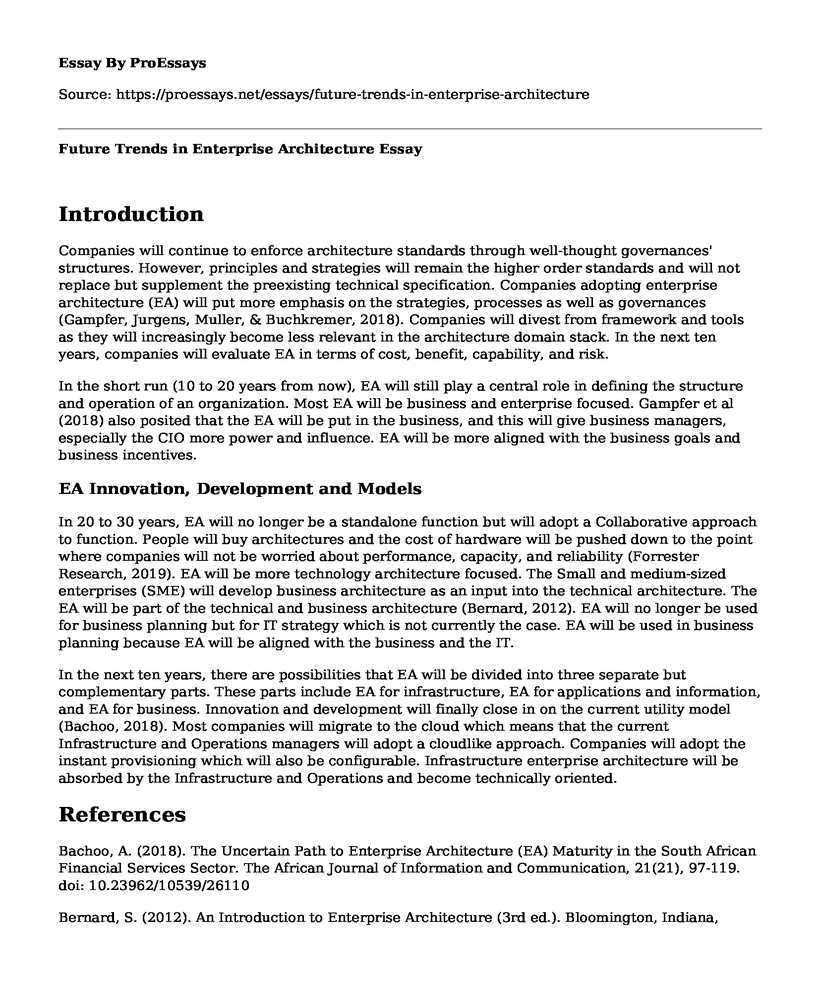Introduction
Companies will continue to enforce architecture standards through well-thought governances' structures. However, principles and strategies will remain the higher order standards and will not replace but supplement the preexisting technical specification. Companies adopting enterprise architecture (EA) will put more emphasis on the strategies, processes as well as governances (Gampfer, Jurgens, Muller, & Buchkremer, 2018). Companies will divest from framework and tools as they will increasingly become less relevant in the architecture domain stack. In the next ten years, companies will evaluate EA in terms of cost, benefit, capability, and risk.
In the short run (10 to 20 years from now), EA will still play a central role in defining the structure and operation of an organization. Most EA will be business and enterprise focused. Gampfer et al (2018) also posited that the EA will be put in the business, and this will give business managers, especially the CIO more power and influence. EA will be more aligned with the business goals and business incentives.
EA Innovation, Development and Models
In 20 to 30 years, EA will no longer be a standalone function but will adopt a Collaborative approach to function. People will buy architectures and the cost of hardware will be pushed down to the point where companies will not be worried about performance, capacity, and reliability (Forrester Research, 2019). EA will be more technology architecture focused. The Small and medium-sized enterprises (SME) will develop business architecture as an input into the technical architecture. The EA will be part of the technical and business architecture (Bernard, 2012). EA will no longer be used for business planning but for IT strategy which is not currently the case. EA will be used in business planning because EA will be aligned with the business and the IT.
In the next ten years, there are possibilities that EA will be divided into three separate but complementary parts. These parts include EA for infrastructure, EA for applications and information, and EA for business. Innovation and development will finally close in on the current utility model (Bachoo, 2018). Most companies will migrate to the cloud which means that the current Infrastructure and Operations managers will adopt a cloudlike approach. Companies will adopt the instant provisioning which will also be configurable. Infrastructure enterprise architecture will be absorbed by the Infrastructure and Operations and become technically oriented.
References
Bachoo, A. (2018). The Uncertain Path to Enterprise Architecture (EA) Maturity in the South African Financial Services Sector. The African Journal of Information and Communication, 21(21), 97-119. doi: 10.23962/10539/26110
Bernard, S. (2012). An Introduction to Enterprise Architecture (3rd ed.). Bloomington, Indiana, United States: AuthorHouse.
Forrester Research. (2019). The Future of EA. Retrieved from https://www.cio.com/article/2372770/the-future-of-ea.html
Gampfer, F., Jurgens, A., Muller, M., & Buchkremer, R. (2018). Past, current and future trends in enterprise architecture-A view beyond the horizon. Computers in Industry, 100(12), 70-84. doi: 10.1016/j.compind.2018.03.006
Cite this page
Future Trends in Enterprise Architecture. (2022, Mar 09). Retrieved from https://proessays.net/essays/future-trends-in-enterprise-architecture
If you are the original author of this essay and no longer wish to have it published on the ProEssays website, please click below to request its removal:
- Social Media Passwords Being Requested in Interviews Essay
- The Story About American Music
- Ideas of Appearance and Illusion in Othello Play Essay
- Double-Take: A Memoir by Kevin Connolly Paper Example
- Nice for What Choreographic Video Evaluation
- Zone of Proximal Development: Benefits for Teaching - Essay Sample
- Essay Example on John Luther Martin: Composing the Beauty of the Desert







